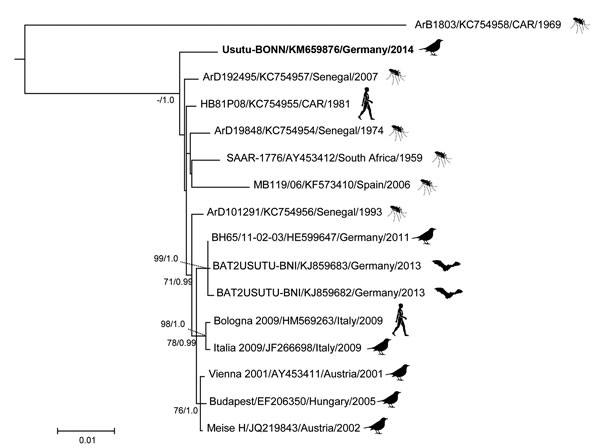Volume 21, Number 9—September 2015
Dispatch
Putative Lineage of Novel African Usutu Virus, Central Europe
Figure 2

Figure 2. Phylogenetic relationship of the Usutu virus Usutu-BONN strain (from Germany, 2014) and other Usutu viruses, based on complete amino acid sequences of the polyprotein-encoding gene. The phylogenetic tree was constructed by using the maximum-likelihood method PhyML 3.0 (12) with 1,000 pseudoreplicates and, in parallel, Bayesian Markov chain Monte Carlo tree-sampling methods by using MrBayes 3.1.2 (13). The Akaike information criterion was chosen as the model selection framework, and the Johnes-Taylor-Thorton model of sequence evolution with gamma-distributed rate variation among sites (JJT + Γ) was chosen as the best model. Maximum-likelihood bootstrap replicate scores (>70%) and posterior probabilities of the Bayesian analysis (>90%) are shown next to the nodes. Taxon information includes strain designation, GenBank accession number, country of origin, and year of detection/isolation. Boldface indicates the Usutu-BONN strain. Scale bar indicates amino acid substitutions per site.
References
- Williams MC, Simpson DI, Haddow AJ, Knight EM. The isolation of West Nile virus from man and of Usutu virus from the bird-biting mosquito Mansonia aurites (Theobald) in the Entebbe area of Uganda. Ann Trop Med Parasitol. 1964;58:367–74 .PubMedGoogle Scholar
- McIntosh BM. Usutu (SA Ar 1776), nouvel arbovirus du groupe B. International Catalogue of Arboviruses. 1985;3:1059–60.
- Nikolay B, Diallo M, Boye CS, Sall AA. Usutu virus in Africa. Vector Borne Zoonotic Dis. 2011;11:1417–23 . DOIPubMedGoogle Scholar
- Weissenböck H, Kolodziejek J, Url A, Lussy H, Rebel-Bauder B, Nowotny N. Emergence of Usutu virus, an African mosquitoborne flavivirus of the Japanese encephalitis virus group, central Europe. Emerg Infect Dis. 2002;8:652–6. DOIPubMedGoogle Scholar
- Becker N, Jöst H, Ziegler U, Eiden M, Höper D, Emmerich P, Epizootic emergence of Usutu virus in wild and captive birds in Germany. PLoS ONE. 2012;7:e32604. http://dx.doi.org/10.1371/ journal.pone.0032604.
- Savini G, Monaco F, Terregino C, Di Gennaro A, Bano L, Pinoni C, Usutu virus in Italy: an emergence or a silent infection? Vet Microbiol. 2011;151:264–74. DOIPubMedGoogle Scholar
- Cadar D, Becker N, Campos Rde M, Börstler J, Jöst H, Schmidt-Chanasit J. Usutu virus in bats, Germany, 2013. Emerg Infect Dis. 2014;20:1771–3. DOIPubMedGoogle Scholar
- Pecorari M, Longo G, Gennari W, Grottola A, Sabbatini A, Tagliazucchi S, First human case of Usutu virus neuroinvasive infection, Italy, August–September 2009. Euro Surveill. 2009;14:19446 .PubMedGoogle Scholar
- Vilibic-Cavlek T, Kaic B, Barbic L, Pem-Novosel I, Slavic-Vrzic V, Lesnikar V, First evidence of simultaneous occurrence of West Nile virus and Usutu virus neuroinvasive disease in humans in Croatia during the 2013 outbreak. Infection. 2014;42:689–95. DOIPubMedGoogle Scholar
- Becker N, Krüger A, Kuhn C, Plenge-Bönig A, Thomas SM, Schmidt-Chanasit J, Mosquitoes as vectors for exotic pathogens in Germany. Bundesgesundheitsblatt Gesundheitsforschung Gesundheitsschutz. 2014;57:531–40. DOIPubMedGoogle Scholar
- Jöst H, Bialonski A, Maus D, Sambri V, Eiden M, Groschup MH, Isolation of Usutu virus in Germany. Am J Trop Med Hyg. 2011;85:551–3. DOIPubMedGoogle Scholar
- Guindon S, Dufayard JF, Lefort V, Anisimova M, Hordijk W, Gascuel O. New algorithms and methods to estimate maximum-likelihood phylogenies: assessing the performance of PhyML 3.0. Syst Biol. 2010;59:307–21 .DOIPubMedGoogle Scholar
- Ronquist F, Huelsenbeck JP. MRBAYES 3: Bayesian phylogenetic inference under mixed models. Bioinformatics. 2003;19:1572–4. DOIPubMedGoogle Scholar
- Liu WJ, Wang XJ, Mokhonov VV, Shi PY, Randall R, Khromykh AA. Inhibition of interferon signaling by the New York 99 strain and Kunjin subtype of West Nile virus involves blockage of STAT1 and STAT2 activation by nonstructural proteins. J Virol. 2005;79:1934–42 .DOIPubMedGoogle Scholar